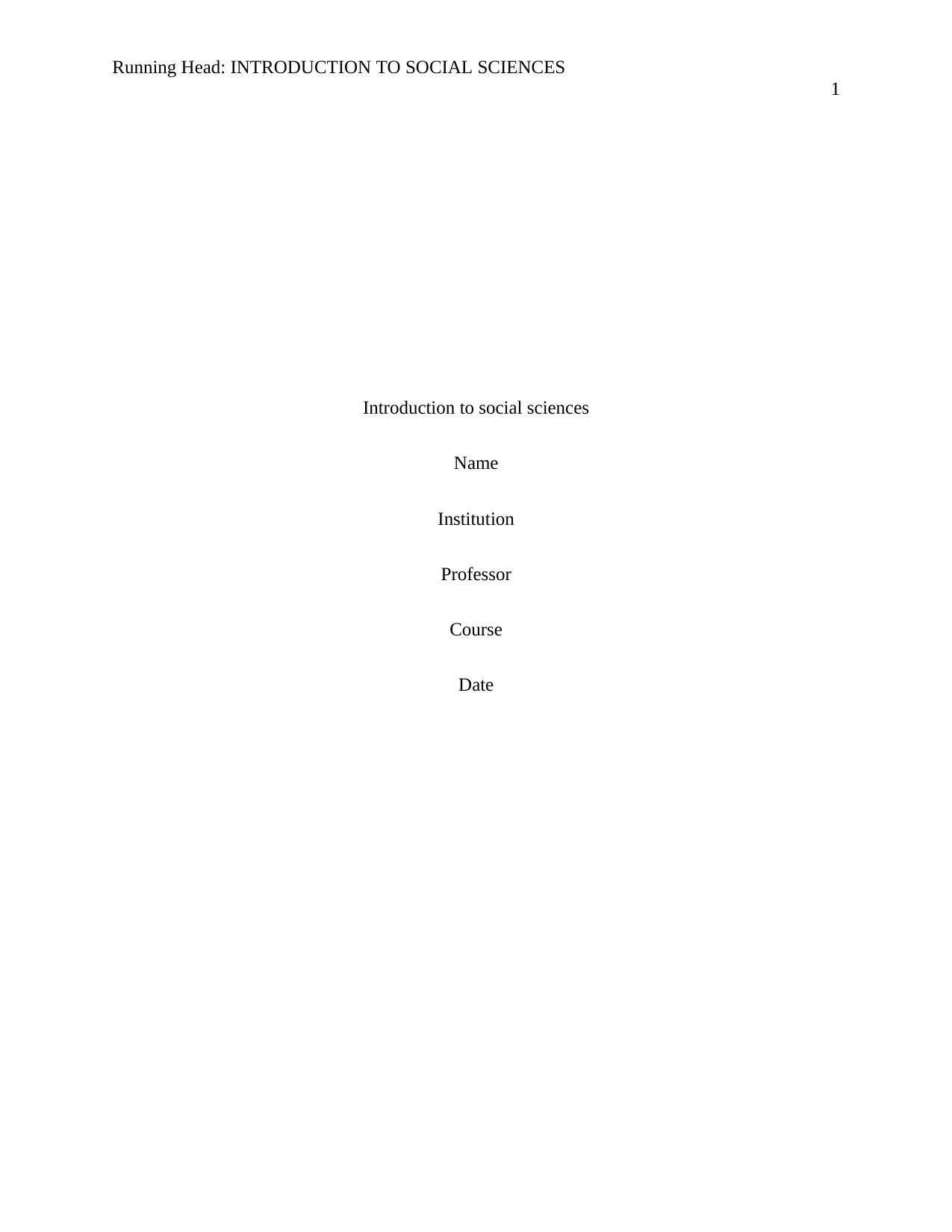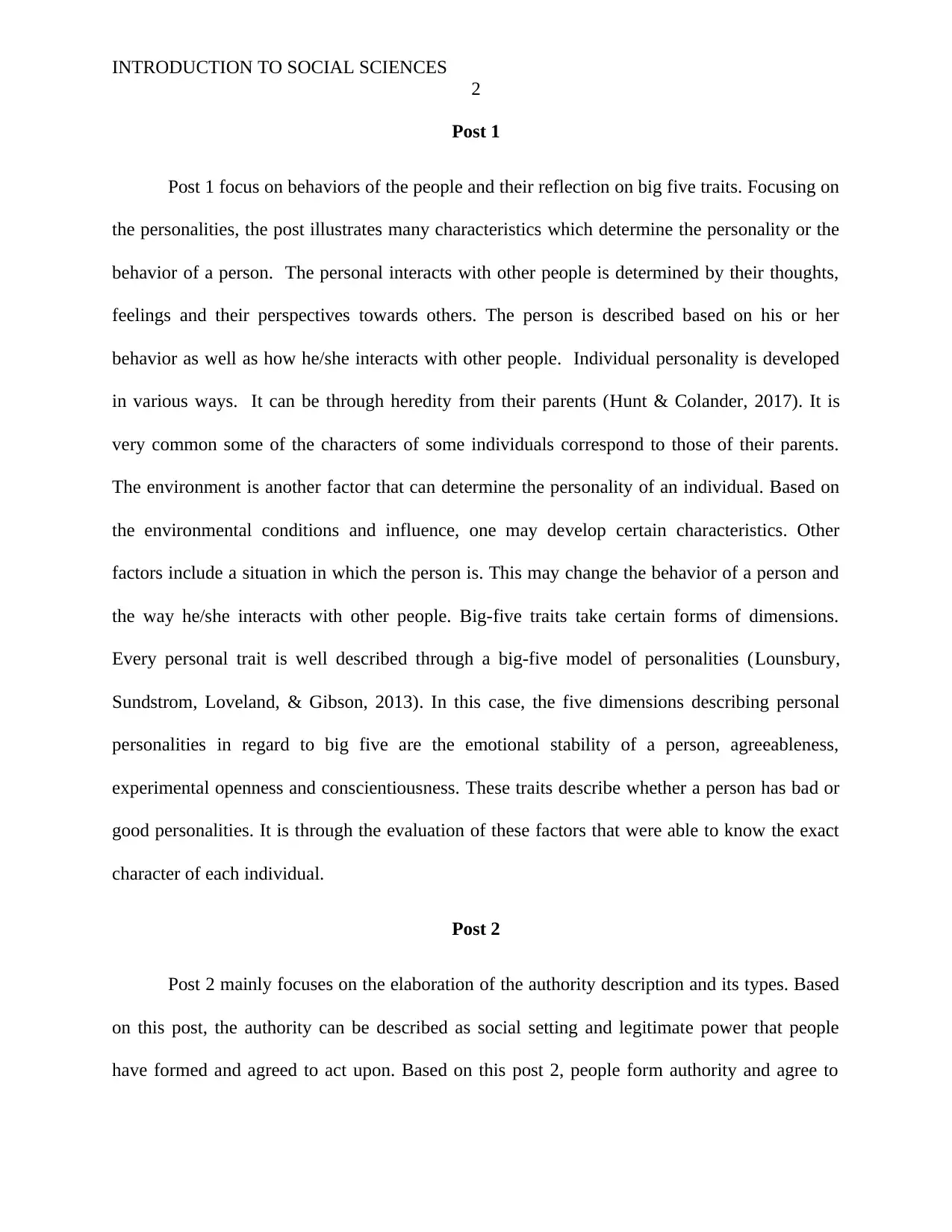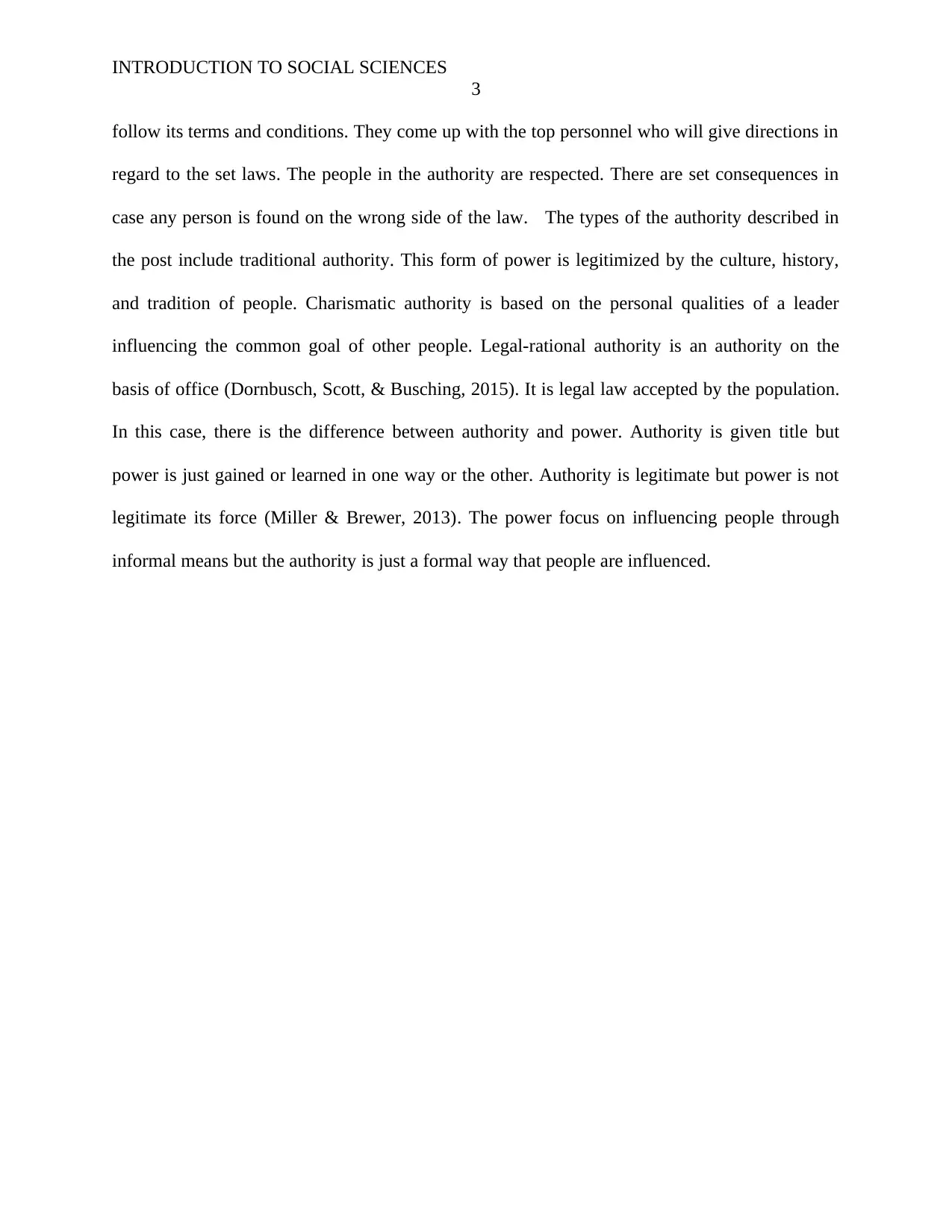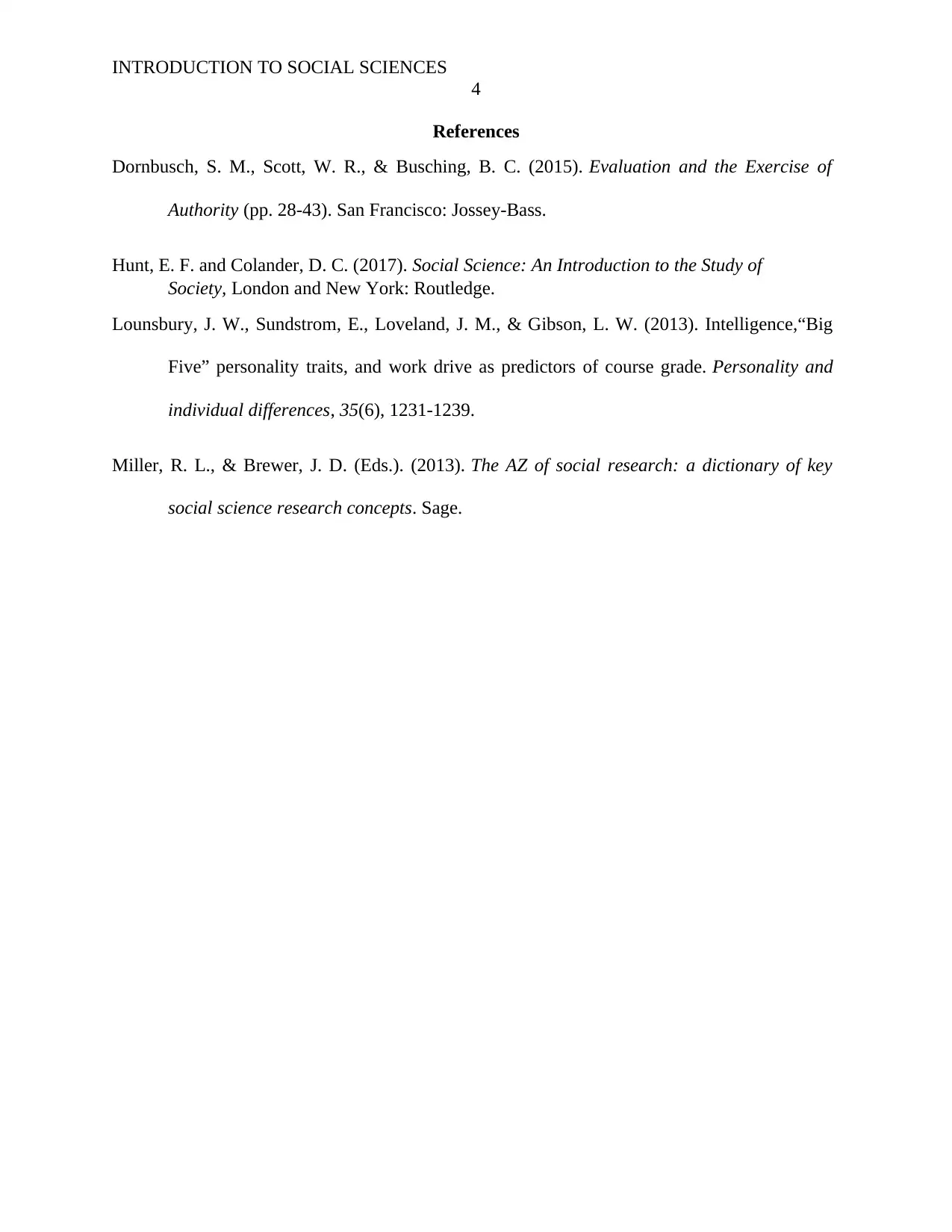SSC109e Introduction to Social Sciences: Authority, Power Analysis
VerifiedAdded on 2023/06/10
|4
|715
|460
Discussion Board Post
AI Summary
This assignment provides an overview of key concepts in social sciences, focusing on personality traits, authority, and power. It analyzes the Big Five personality traits and their influence on individual behavior and interactions. Furthermore, it elaborates on different types of authority, including traditional, charismatic, and legal-rational authority, as defined by Max Weber, highlighting the distinctions between authority and power. The discussion emphasizes how these concepts shape social structures and individual actions within society. This document is available on Desklib, a platform offering a range of study tools and solved assignments to support student learning.

Running Head: INTRODUCTION TO SOCIAL SCIENCES
1
Introduction to social sciences
Name
Institution
Professor
Course
Date
1
Introduction to social sciences
Name
Institution
Professor
Course
Date
Paraphrase This Document
Need a fresh take? Get an instant paraphrase of this document with our AI Paraphraser

INTRODUCTION TO SOCIAL SCIENCES
2
Post 1
Post 1 focus on behaviors of the people and their reflection on big five traits. Focusing on
the personalities, the post illustrates many characteristics which determine the personality or the
behavior of a person. The personal interacts with other people is determined by their thoughts,
feelings and their perspectives towards others. The person is described based on his or her
behavior as well as how he/she interacts with other people. Individual personality is developed
in various ways. It can be through heredity from their parents (Hunt & Colander, 2017). It is
very common some of the characters of some individuals correspond to those of their parents.
The environment is another factor that can determine the personality of an individual. Based on
the environmental conditions and influence, one may develop certain characteristics. Other
factors include a situation in which the person is. This may change the behavior of a person and
the way he/she interacts with other people. Big-five traits take certain forms of dimensions.
Every personal trait is well described through a big-five model of personalities (Lounsbury,
Sundstrom, Loveland, & Gibson, 2013). In this case, the five dimensions describing personal
personalities in regard to big five are the emotional stability of a person, agreeableness,
experimental openness and conscientiousness. These traits describe whether a person has bad or
good personalities. It is through the evaluation of these factors that were able to know the exact
character of each individual.
Post 2
Post 2 mainly focuses on the elaboration of the authority description and its types. Based
on this post, the authority can be described as social setting and legitimate power that people
have formed and agreed to act upon. Based on this post 2, people form authority and agree to
2
Post 1
Post 1 focus on behaviors of the people and their reflection on big five traits. Focusing on
the personalities, the post illustrates many characteristics which determine the personality or the
behavior of a person. The personal interacts with other people is determined by their thoughts,
feelings and their perspectives towards others. The person is described based on his or her
behavior as well as how he/she interacts with other people. Individual personality is developed
in various ways. It can be through heredity from their parents (Hunt & Colander, 2017). It is
very common some of the characters of some individuals correspond to those of their parents.
The environment is another factor that can determine the personality of an individual. Based on
the environmental conditions and influence, one may develop certain characteristics. Other
factors include a situation in which the person is. This may change the behavior of a person and
the way he/she interacts with other people. Big-five traits take certain forms of dimensions.
Every personal trait is well described through a big-five model of personalities (Lounsbury,
Sundstrom, Loveland, & Gibson, 2013). In this case, the five dimensions describing personal
personalities in regard to big five are the emotional stability of a person, agreeableness,
experimental openness and conscientiousness. These traits describe whether a person has bad or
good personalities. It is through the evaluation of these factors that were able to know the exact
character of each individual.
Post 2
Post 2 mainly focuses on the elaboration of the authority description and its types. Based
on this post, the authority can be described as social setting and legitimate power that people
have formed and agreed to act upon. Based on this post 2, people form authority and agree to

INTRODUCTION TO SOCIAL SCIENCES
3
follow its terms and conditions. They come up with the top personnel who will give directions in
regard to the set laws. The people in the authority are respected. There are set consequences in
case any person is found on the wrong side of the law. The types of the authority described in
the post include traditional authority. This form of power is legitimized by the culture, history,
and tradition of people. Charismatic authority is based on the personal qualities of a leader
influencing the common goal of other people. Legal-rational authority is an authority on the
basis of office (Dornbusch, Scott, & Busching, 2015). It is legal law accepted by the population.
In this case, there is the difference between authority and power. Authority is given title but
power is just gained or learned in one way or the other. Authority is legitimate but power is not
legitimate its force (Miller & Brewer, 2013). The power focus on influencing people through
informal means but the authority is just a formal way that people are influenced.
3
follow its terms and conditions. They come up with the top personnel who will give directions in
regard to the set laws. The people in the authority are respected. There are set consequences in
case any person is found on the wrong side of the law. The types of the authority described in
the post include traditional authority. This form of power is legitimized by the culture, history,
and tradition of people. Charismatic authority is based on the personal qualities of a leader
influencing the common goal of other people. Legal-rational authority is an authority on the
basis of office (Dornbusch, Scott, & Busching, 2015). It is legal law accepted by the population.
In this case, there is the difference between authority and power. Authority is given title but
power is just gained or learned in one way or the other. Authority is legitimate but power is not
legitimate its force (Miller & Brewer, 2013). The power focus on influencing people through
informal means but the authority is just a formal way that people are influenced.
⊘ This is a preview!⊘
Do you want full access?
Subscribe today to unlock all pages.

Trusted by 1+ million students worldwide

INTRODUCTION TO SOCIAL SCIENCES
4
References
Dornbusch, S. M., Scott, W. R., & Busching, B. C. (2015). Evaluation and the Exercise of
Authority (pp. 28-43). San Francisco: Jossey-Bass.
Hunt, E. F. and Colander, D. C. (2017). Social Science: An Introduction to the Study of
Society, London and New York: Routledge.
Lounsbury, J. W., Sundstrom, E., Loveland, J. M., & Gibson, L. W. (2013). Intelligence,“Big
Five” personality traits, and work drive as predictors of course grade. Personality and
individual differences, 35(6), 1231-1239.
Miller, R. L., & Brewer, J. D. (Eds.). (2013). The AZ of social research: a dictionary of key
social science research concepts. Sage.
4
References
Dornbusch, S. M., Scott, W. R., & Busching, B. C. (2015). Evaluation and the Exercise of
Authority (pp. 28-43). San Francisco: Jossey-Bass.
Hunt, E. F. and Colander, D. C. (2017). Social Science: An Introduction to the Study of
Society, London and New York: Routledge.
Lounsbury, J. W., Sundstrom, E., Loveland, J. M., & Gibson, L. W. (2013). Intelligence,“Big
Five” personality traits, and work drive as predictors of course grade. Personality and
individual differences, 35(6), 1231-1239.
Miller, R. L., & Brewer, J. D. (Eds.). (2013). The AZ of social research: a dictionary of key
social science research concepts. Sage.
1 out of 4
Related Documents
Your All-in-One AI-Powered Toolkit for Academic Success.
+13062052269
info@desklib.com
Available 24*7 on WhatsApp / Email
![[object Object]](/_next/static/media/star-bottom.7253800d.svg)
Unlock your academic potential
Copyright © 2020–2025 A2Z Services. All Rights Reserved. Developed and managed by ZUCOL.





